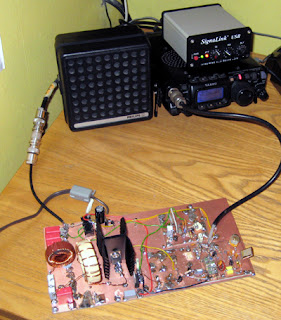For the receiver I built the first stage of the optical head described in the RadCom articles (March-May 2011) using an identical red LED (reverse biased) as the detector. I also tried a BPW34 detector, but it was not that different. This was followed by a couple common emitter transistor stages using my ubiquitous 2N3904s feeding a crystal earpiece. With the TX "beacon" running from a 9V battery and aiming out of my garage I walked across the road with the receiver and a 4 inch magnifying glass. Across the road, at about 25m range, this produced a quite respectable signal as long as the magnifying glass was focussed onto the RX LED. This was all a bit "Heath-Robinson" as I had to hold everything in my hand and move things around to get it spot on. There was quite a bit of interference from the street lights nearby.
I have no idea how much "antenna" gain there is in the built-in lens on the TX LED (a few dB?) or with the magnifying glass on the RX but with this set-up correctly aligned I would think 100m range is certainly possible. This is just the beginning of a series of tests, but I am already happy that the optical head is sensitive and that good, well aligned optics will be essential to get decent distances. More TX power is easily available by using a power LED.
Next stages are:
- A better beacon TX capable of operating at higher power on both baseband and subcarrier frequencies.
- Putting the optical head into a screened enclosure, even if a temporary one.
- Starting to think about optics. Using the same LED on both RX and TX will save on optics as just one set is needed at each end of the link.





